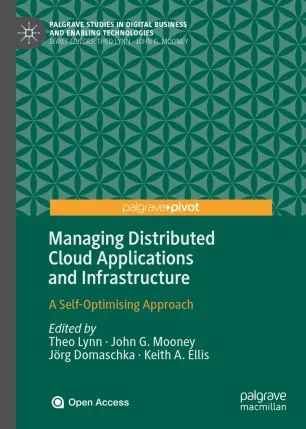Managing Distributed Cloud Applications and Infrastructure: A Self-Optimising Approach
4.0
Reviews from our users

You Can Ask your questions from this book's AI after Login
Each download or ask from book AI costs 2 points. To earn more free points, please visit the Points Guide Page and complete some valuable actions.Introduction
The evolution of cloud computing has revolutionized the IT landscape, offering incredible opportunities for scalability, cost-efficiency, and innovation. However, the complexity of managing distributed cloud applications and infrastructure has also become a significant challenge for administrators, developers, and businesses alike. Managing Distributed Cloud Applications and Infrastructure: A Self-Optimising Approach delves into this complexity, offering insights and practical solutions that leverage self-optimizing mechanisms to simplify and enhance the management of modern cloud systems.
The book is not merely an academic exploration of the topic but a hands-on guide that combines theory with actionable strategies. Aimed at cloud practitioners, IT professionals, and researchers, it builds a framework for managing distributed environments efficiently while maintaining performance, reliability, and cost-effectiveness. Offering a comprehensive analysis of concepts such as automation, optimization, and system resilience, this book bridges the gap between abstract principles and real-world application.
Detailed Summary of the Book
This book is structured to guide readers through the core principles of managing distributed cloud systems, emphasizing self-optimization as a transformative approach to achieving operational success in complex cloud-based ecosystems.
At its core, the book examines the challenges inherent in distributed systems—such as latency, network congestion, and infrastructure scaling—while proposing methodologies to address these pain points. It begins by laying theoretical groundwork, explaining the building blocks of cloud infrastructure and distributed systems. Readers are introduced to concepts like load balancing, containerization, microservices, and dynamic performance tuning.
The subsequent chapters delve into self-optimizing mechanisms, incorporating elements of artificial intelligence, machine learning, and predictive analytics. These technologies are explored in-depth as enablers for automating routine management tasks such as resource allocation, failure recovery, and energy consumption management. The authors highlight how these techniques can be seamlessly integrated into cloud architectures to continuously refine application delivery and infrastructure efficiency.
In addition to technical knowledge, the book also provides case studies and industry insights that showcase real-world implementations of self-optimizing solutions. By walking readers through these examples, it demonstrates how theoretical models translate into practical tools for addressing scalability, resilience, and cost challenges. The unique blend of foundational knowledge and practical examples makes this book indispensable to a wide variety of audiences.
Key Takeaways
- Understanding Distributed Systems: Gain a deep understanding of distributed cloud systems and their distinct management challenges.
- Self-Optimization Principles: Explore self-optimizing strategies that automate routine tasks and enhance resource utilization.
- Technology Integration: Learn how to leverage AI, machine learning, and predictive analytics in cloud environments.
- Hands-On Applications: Discover practical tools and techniques through detailed case studies and examples.
- Future-Proofing Systems: Design resilient, scalable, and cost-effective cloud architectures fit for long-term growth.
Famous Quotes from the Book
"The cloud isn't just a platform anymore; it's an ever-evolving ecosystem requiring dynamic, intelligent management."
"To truly optimize, one must automate. Manual intervention is the antithesis of scalability."
"The future of cloud computing lies in its ability to self-heal, self-scale, and self-optimize without human oversight."
Why This Book Matters
Cloud computing continues to shape the modern technological landscape, becoming a cornerstone of digital transformation for enterprises across industries. However, the complexity of distributed systems, combined with a rapidly evolving technology stack, necessitates a sophisticated understanding of operational efficiency in such environments. Managing Distributed Cloud Applications and Infrastructure: A Self-Optimising Approach provides precisely that.
By focusing on self-optimizing principles, the book addresses a critical gap in the market—to simplify and streamline cloud management effectively. It empowers readers with the tools they need to handle ever-increasing complexities while delivering cost-effective and reliable cloud services. Furthermore, it fosters an understanding of how to build systems designed for long-term adaptability, an approach that's imperative in today’s fast-changing IT climate.
Whether you are tasked with managing a complex cloud infrastructure, researching cutting-edge optimization techniques, or architecting resilient distributed applications, this book offers the depth and clarity you need to succeed. Its blend of technical rigor and real-world applicability ensures it remains a valuable resource for years to come.
Free Direct Download
You Can Download this book after Login
Accessing books through legal platforms and public libraries not only supports the rights of authors and publishers but also contributes to the sustainability of reading culture. Before downloading, please take a moment to consider these options.
Find this book on other platforms:
WorldCat helps you find books in libraries worldwide.
See ratings, reviews, and discussions on Goodreads.
Find and buy rare or used books on AbeBooks.
1090
بازدید4.0
امتیاز50
نظر98%
رضایتReviews:
4.0
Based on 0 users review
"کیفیت چاپ عالی بود، خیلی راضیام"
Questions & Answers
Ask questions about this book or help others by answering
No questions yet. Be the first to ask!


